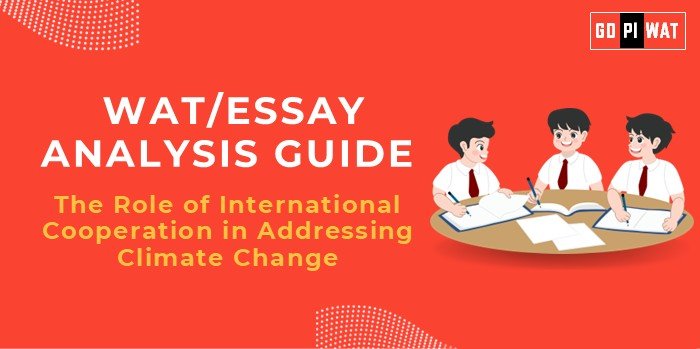📋 WAT/Essay Analysis Guide
🌍 Understanding the Role of International Cooperation in Addressing Climate Change
🕒 Effective Planning and Writing
- Time Allocation: 5 minutes planning, 20 minutes writing, 5 minutes review.
- Preparation Tips: Identify key treaties, stakeholders, and recent developments.
📜 Introduction Techniques
- Contrast Approach: “While climate summits emphasize unity, global emissions have reached record highs, revealing a gap between ambition and action.”
- Solution-Based Approach: “International collaboration offers the only viable path to curbing climate change, as evidenced by the success of the Montreal Protocol.”
📂 Structuring the Essay Body
- 🌟 Achievements: Highlight successes like renewable energy milestones and international frameworks.
- ⚠️ Challenges: Examine disparities in funding and accountability gaps.
- 🔮 Future Outlook: Propose solutions like enhanced carbon pricing and technology transfers.
📄 Concluding Effectively
- ⚖️ Balanced Conclusion: “International cooperation remains the cornerstone of climate mitigation, demanding equitable and accountable efforts across nations.”
- 🌐 Global Perspective Conclusion: “From Europe’s carbon leadership to Africa’s renewable growth, the climate fight exemplifies both challenges and hopes of collective action.”
✨ Recommendations for Sustainable Progress
- 🌍 Expand the scope of the Green Climate Fund.
- ⚖️ Introduce binding sanctions for non-compliance with climate commitments.
📚 Sample Short Essays
- 💡 Balanced Approach: “While international cooperation underpins global climate strategy, gaps in implementation hinder progress. Addressing these requires equitable funding and robust accountability mechanisms.”
- 🚀 Solution-Oriented: “Scaling up renewable technology sharing and funding for vulnerable nations are key to achieving net-zero targets globally.”
- 🌏 Global Comparison: “Successes like the EU’s emissions trading highlight the potential of cooperation, yet emerging economies need tailored solutions to bridge climate inequalities.”


